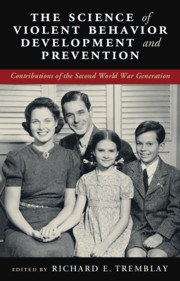 The Science of Violent Behavior Development and Prevention
The Science of Violent Behavior Development and Prevention Book contents
- The Science of Violent Behavior Development and Prevention
- The Science of Violent Behavior Development and Prevention
- Copyright page
- Contents
- Preface
- 1 Introduction: A Young Science with a Long History
- 2 From Birth in a British Orphanage to Assessments of American Indians’ Development
- 3 From Rationing, Illness, and Stress to the Creation of a Major Longitudinal Birth Cohort
- 4 From Country Girl in Southern Finland to Longitudinal Research into Alternatives to Aggression and Violence
- 5 From the Occupied Netherlands to the Pittsburgh Longitudinal Studies
- 6 From Boy to Man
- 7 Nurture and Nature
- 8 From Unruly Child to Political Protester and Promoter of an Ecology-Minded Concept of Development
- 9 From the Frustration–Aggression Hypothesis to Moral Reasoning and Action
- 10 A Tortuous Path towards Understanding and Preventing the Development of Chronic Physical Aggression
- 11 From Childhood in a Ruined German City to Research on Crime and Violence
- 12 The Last War Baby
- 13 Comments on the Autobiographies of the World War II Babies by Younger Peers
- Index
- References
6 - From Boy to Man
From Delinquent Development to Old Age Crime
Published online by Cambridge University Press: 28 January 2021
- The Science of Violent Behavior Development and Prevention
- The Science of Violent Behavior Development and Prevention
- Copyright page
- Contents
- Preface
- 1 Introduction: A Young Science with a Long History
- 2 From Birth in a British Orphanage to Assessments of American Indians’ Development
- 3 From Rationing, Illness, and Stress to the Creation of a Major Longitudinal Birth Cohort
- 4 From Country Girl in Southern Finland to Longitudinal Research into Alternatives to Aggression and Violence
- 5 From the Occupied Netherlands to the Pittsburgh Longitudinal Studies
- 6 From Boy to Man
- 7 Nurture and Nature
- 8 From Unruly Child to Political Protester and Promoter of an Ecology-Minded Concept of Development
- 9 From the Frustration–Aggression Hypothesis to Moral Reasoning and Action
- 10 A Tortuous Path towards Understanding and Preventing the Development of Chronic Physical Aggression
- 11 From Childhood in a Ruined German City to Research on Crime and Violence
- 12 The Last War Baby
- 13 Comments on the Autobiographies of the World War II Babies by Younger Peers
- Index
- References
Summary
David P. Farrington was born in 1944 in England and is Emeritus Professor of Criminology at the University of Cambridge. He is director of the Cambridge Study in Delinquent Development (CSDD), which wasinitiated in 1961 by Donald West with 411 males in London, England, who are still followed. The study advanced knowledge about offending and antisocial behavior; drug and alcohol use; risk factors for aggression, violence, bullying, and intimate partner violence from childhood to adulthood; and the relationship between offending and other life problems, such as in accommodation, relationships, and employment. It has advanced knowledge about risk factors for offending, especially those measured in childhood, such as impulsiveness, low school achievement, poor parental supervision, and disrupted families. It has also advanced knowledge about the effects of life events – such as getting married, becoming separated, and becoming unemployed – on the course of development of offending, as well as the intergenerational transmission of antisocial behavior. Farrington has consistently advocated for early intervention targeting risk factors in order to reduce offending.For example, poor parenting can be targeted using home visiting and parent management training, impulsiveness can be targeted with skills training, and low achievement can be targeted in preschool intellectual enrichment programs.
Keywords
- Type
- Chapter
- Information
- The Science of Violent Behavior Development and PreventionContributions of the Second World War Generation, pp. 122 - 154Publisher: Cambridge University PressPrint publication year: 2021
References
- 2
- Cited by
